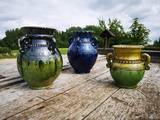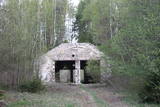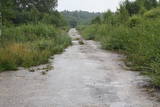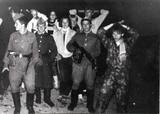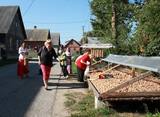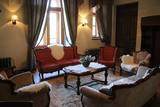| Nr | Name | Beschreibung |
|---|---|---|
|
The craftsman produces pottery typical of Vidzeme, but with the range of colours that is typical of Latgale. These products fit in very nicely with the lovely landscape of Racupkalns. You can take a tour, watch the master at work, and work with clay yourself. You can also watch as he opens a Lettigalian ditch kiln. You can commission and purchase the products, as well. |
||
|
Одна из самых красивых набережных Латвии. Расположена в северной части Старого города Вентспилса. Началом набережной на улице Остас в восточной ее части служит «Тиргоню дарзс» (здесь же Вентспилсский ТИЦ) и Юракменс. Набережная украшена скульптурами коров, памятниками, фонтанами и цветочными композициями. До середины прошлого столетия на улице Остас находились склады - амбары, часть из которых сохранилась. Напротив замка Ливонского ордена установлен памятник Кришьянису Валдемару. У пристани стоит кораблик «Герцог Екаб». |
||
|
This park was set up to protect the lovely ancient valley of the Dubysa River. This is one of the most popular rivers for water tourism in Lithuania, because it has a significant drop with rapids and beautiful shorelines.
|
||
|
Līdz 18. gs. šajā vietā bija koka baznīca, kamēr 1798. g. uzcēla mūra baznīcu, kas cieta 1. pasaules karā, bet 2. pasaules kara laikā to uzspridzināja. Tikai pusgadsimtu vēlāk - 1991. gadā tika uzsākti atjaunošanas darbi, kas joprojām turpinās. Tagad redzamais dievnams ir iepriekšējā līdzinieks. |
||
|
Es ist ein einzigartiges Naturgebiet und kulturgeschichtliches Gebiet zwischen Kaldabruņa, Bebrene und Dviete. Durch das Urstromtal fließt der kleine Fluss Dviete, der die Seen Skuķu ezers und Dvietes ezers und die Wiesen der Flussniederung durchquert. Während der Hochwasserzeit arbeiten diese Wasserbecken als Reservoir für die Gewässer des Flusses Daugava, weil sie umfangreiche Hochwassermassen schnell aufnehmen und später langsam zurückgeben können. Wenn es im Frühling sehr viel Wasser gibt, dann ähneln die hier sichtbaren Landschaften keiner anderen in Lettland. Diese Besonderheit der Wasserstandschwankungen ist der Grund, warum dieser Ort für Pflanzen und für Vögel während der Migrations- und Nistzeit von Bedeutung ist. Zum Schutz des Gebietes ist der Naturpark der Flussniederung von Dviete eingerichtet worden. Es ist interessant, dass die höheren Stellen, die während des Hochwassers nicht überschwemmt werden, Inseln genannt werden. Im Urstromtal von Dviete sind 15 eventuelle alte Siedlungen (aus der Steinzeit, Bronzezeit und Eisenzeit) gefunden und viele Zufallsfunde mit verschiedenen Gegenständen ausgegraben worden. Man hat allen Grund zu glauben, dass dieser Ort einer der ältesten und bedeutendsten Wohnorte auf dem heutigen Gebiet von Südlettland ist. |
||
|
Ein alter Burghügel der Kurši, mit Funden, die auf eine alte Siedlung hindeuten. Geschichtliche Quellen bezeugen, dass 1263 der Stamm der Kurši die Burg kampflos dem Livonischen Orden zum Niederbrennen überlassen habe. Der Ursprung der Ortsbezeichnung Skābaržkalns (Buchenberg) ist im Zusammenhang mit dem Namen der Stadt zu sehen, denn skābarži (Buchen) wurden ihrerzeit in Kurland als „grobi“ (daher Grobiņa) bezeichnet. |
||
|
Lauku sēta ar pirti atrodas Merkys upes krastā, ciema nomalē meža tuvumā. Piedāvā programmu "Griķu ceļš no sēklas līdz galdam", iespējams nobaudīt tradicionālos ēdienus. Piedāvā arī nakšņošanu. |
||
|
Das Restaurant am Ufer von Lielupe in Jūrmala bietet moderne lettische Küche und regionale Produkte. Das besondere Angebot des Restaurants sind geräucherte Produkte, deren Zubereitung auf Traditionen und jahrelanger Erfahrung basiert. Das Restaurant ist im renommierten Nordic White Guide und in den Top 30 der lettischen Restaurants 2019 enthalten. |
||
|
The small bar is situated in the city of Madona and there are seating places for 35 people. |
||
|
Atrodas Bauskas centrā, Kalna iela 6. Muzeja piedāvājumā ir ekspozīcija „Bauska laikā un cilvēki Bauskā 20 gs., pastaiga un atraktīvs piedzīvojums”. |
||
|
An einem schwer zugänglichen Ort in Wälder von Bārta ist die Station der Raketen von Plāņciems gelegen. Die Station ist ein besonderes ehemaliges Militärobjekt der UdSSR, das für die Flugabwehr diente. Die Objekte werden zum Zweck der Baustoffe – Gewinnung demontiert.
|
||
|
Südlich von Gardene war in der Zeit der Sowjetunion einer von der größten Militärversuchsfelder der Panzer in baltischen Kriegsgebiet. Heutzutage wird der größte Teil des Militärversuchsfeldes nicht bewirtschaftet und das Territorium bewächst langsam. Im Territorium sind einzelne Gebäudefragmente oder Ruinen u.a. für die Militärversuchsfelder charakteristischen Elemente erhalten geblieben. Von dem Weg Dobele – Annenieki, der nach Militärversuchsfeld führt, zweigt sich ein betonierter Armeeweg ab, der auch heute benutzt werden kann. Die Bebauung von Gardenes ist auch sehr interessant – die Gebäude und die Planung der Gebäude. In dieser Zeit wohnten in Gardene die Soldaten der sowjetischen Armee und ihre Familien.
|
||
|
Also known as Lake Jēsis or Lake Iesis, this is the lake in Latvia which has the largest number of islands. Many literary sources and encyclopaedias in the 20th century claimed that there were 69 islands in the lake, but that was an exaggeration, because apparently the authors took sandbars overgrown with reeds and other plants to be islands. The true number is approximately two times lesser. The largest number of islands can be found in the north-eastern part of the lake. The largest one is Lielā Lāča (Big Bear) Island (45 ha). A farm was on the island at one time. The islands and the oak trees that are on the shores of the lake – the Piļoru and Pahatnīku stands of trees – are in a restricted environmental reserve. |
||
|
The cafe Staburadze is situated in the centre of the city Kuldiga. |
||
|
The Soviet Border Guard arrived at Lapmežciems (its border with Ragaciems) in the mid-1960s and left in 1991. Some 50 military personnel were stationed here. The military personnel and local residents organised various events and celebrations. The only thing that worried locals was a radar which was said to cause various problems. The zenith missiles were dismantled and taken away in 1991. An apartment building is still on what was then the military base. |
||
|
Am Ufer von Peipussee befinden sich dicht nacheinander Dörfer, die vor Jahrhunderte von den Altgläubigen, die aus Russland entflohen haben, bewohnt wurden - Kolkja, Kasepää und Varnja. |
||
|
The castle was built as an almost exact copy of the architecture of Windsor Castle in the UK and is among the most unusual of the Estonian manor buildings. At least as interesting is the owner and initiator of the manor building design - Count Friedrich von Berg. There is also a Dendro park with rare species behind the Castle. |
||
|
Das Museum befindet sich in Aknīste, an der Kreuzung der Skolas Straße und Miera Straße. Dieses Museum ist noch ein Ort, der bei der Erkundung der Kultur und der Geschichte der Region Sēlija helfen wird. In dem Museum (eingerichtet im Jahr 1988) kann man eine Sammlung von Altertümern (aus der Steinzeit und Bronzezeit) und Gegenstände besichtigen, die über berühmte Persönlichkeiten aus der Gegend und die Kultur der Selen erzählen. Besonders wertvoll ist die Sammlung des Geschirrs der Selen. |
||
|
Die Bar befindet sich in dem erneuerten Komplex des Landgutes von Smukas (16.Jh.). Im Sommer kann man die Mahlzeit auf der Terrasse des Gästehauses Zirgu stallis, aber im Winter am Kamin in der Bar genießen. Lettische Küche: Vesperbrot der Kurländer (Milchsuppe mit Klößen und einem geräucherten Speck), auf Kohlen gebackener Hering, geschichtetes Roggenbrot-Dessert mit Schlagsahne, ländlicher Milchfladen (Erstmilch, Zucker, Zimt, Gartenbeerensoße), Käsekartoffel mit einem im Honig gebackenen Schweinebraten. |
||
|
Arī 18. novembra laukums. Tas sācis veidoties 18. gadsimtā kā tirgus laukums. Tā dominantes bija 1752. g. celtais rātsnams (nav saglabājies) un aptieka, kas šajā ēkā darbojas no 1810. g. līdz pat mūsdienām. 2010. gadā laukumā izveidota strūklaka, kam ir pilsētas ģerboņa forma. |
||
